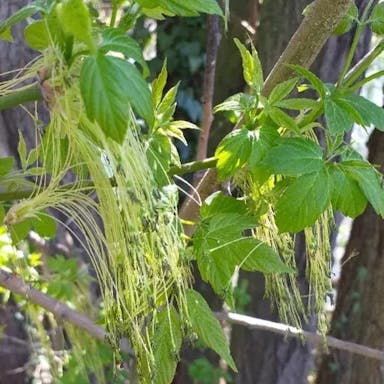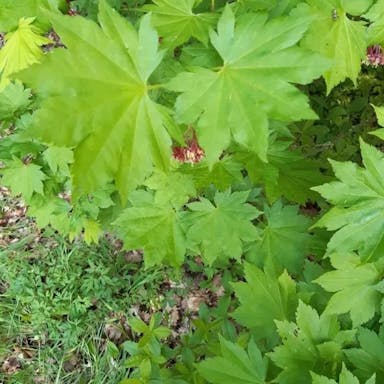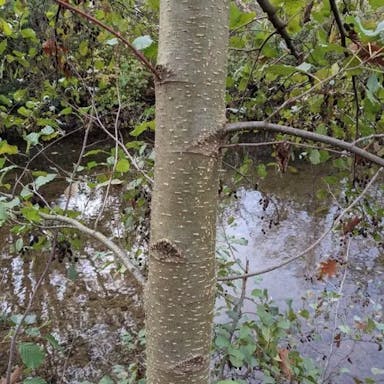Eastern hornbeam, scientifically known as Carpinus orientalis, is a deciduous tree native to southeastern Europe and western Asia. It is characterized by smooth, gray bark and distinctive serrated leaves that turn yellow-orange in the fall. The tree produces inconspicuous flowers in spring, followed by small, winged nutlets that resemble hop fruits. Carpinus orientalis is often used in landscaping for its attractive foliage and ability to tolerate urban conditions. It typically grows to a height of 30-50 feet with a spread of 20-35 feet, making it suitable for medium-sized gardens. The tree is relatively low-maintenance and adapts to various soil types, although it prefers well-drained, slightly acidic soil. Eastern hornbeam is valued for its dense, compact growth habit, making it ideal for hedges and screens. The wood is also prized for its strength and durability, commonly used in furniture making and tool handles.
Eastern hornbeam
- Scientific name
- Carpinus orientalis
Basic Information
- Betulaceae Family Carpinus Genus Eastern hornbeam Species
- Betulaceae > Carpinus > Carpinus orientalis
- 83%
- The Completeness of This Encyclopedia
Please help us complete the encyclopedia, Terrarium is a encyclopedia service to be completed with everyone in the world. Currently, this page is 83% complete. For more information on how to contribute, please click here.
- Broad-leaved tree
- Tree
- Height
- 1000cm ~
- Flower Color
- Leaf Color
- Anthesis
- spring
- Sunlight Exposure
Full Sun Long hours of sunlight from morning to afternoon Partial Shade A location in the shade of a tree or where either the morning or afternoon is shaded Full Shade A place where there is no direct sunlight
- Partial Shade
- Hardiness Zones
This is an indicator to know to which zone each plant can winter. Knowing the zone of each plant gives you an idea of the cold temperature resistance when grown in the ground without a roof. 2: -42.7 to -40.0 3: -39.9 to -34.4 4: -34.3 to -28.9 5: -28.8 to -23.3 6: -23.2 to -17.8 7: -17.7 to -12.2 8: -12.1 to -6.7 9: -6.6 to -1.1 10: -1.0 to 4.4 11: 4.5 to 10.0
- 5
- Cold resistance
- Good
- Heat resistance
- Good
- Habitat of origin
- Southeast Europe, Western Asia
- Growth Rate
- Slow
What is Eastern hornbeam (Carpinus orientalis)?
What is Eastern hornbeam (Carpinus orientalis)
Flower meaning
Eastern hornbeam, scientifically known as Carpinus orientalis, is a deciduous tree native to Southeastern Europe and Western Asia. It is characterized by its smooth, gray bark and distinctive serrated leaves that turn vibrant shades of yellow and orange in the fall. The tree produces inconspicuous flowers in spring, followed by small, winged nutlets that resemble hop fruits. Carpinus orientalis is often used in landscaping for its attractive foliage and compact size, reaching heights of 30-50 feet. It is relatively easy to grow, thriving in well-drained soil and full sun to partial shade. The tree symbolizes endurance and resilience, making it a popular choice for ornamental gardens and urban environments. There are several cultivars of Carpinus orientalis, each with unique characteristics such as leaf shape and growth habit.
0
0
Calendar of Eastern hornbeam (Carpinus orientalis)
Calendar
Eastern hornbeam is susceptible to various pests and diseases, including aphids, caterpillars, and powdery mildew. These pests can cause damage to the leaves, leading to discoloration and deformities. Aphids are small insects that feed on the sap of the plant, causing wilting and stunted growth. Caterpillars can chew on the leaves, creating holes and weakening the plant. Powdery mildew is a fungal disease that appears as a white powdery substance on the leaves, inhibiting photosynthesis. To prevent these issues, regular inspection of the plant is essential to detect any signs of pests or diseases early. Additionally, maintaining proper air circulation around the plant and avoiding overhead watering can help prevent powdery mildew. Withering of Eastern hornbeam can occur due to the damage caused by these pests and diseases, leading to a decline in overall health and vigor.
0
0
How to grow Eastern hornbeam (Carpinus orientalis)
Watering
The flower language commonly used in America for the Eastern hornbeam is: - Strength - Resilience - Endurance One typical example is "Strength," symbolizing the ability to withstand challenges and difficulties, much like the Eastern hornbeam tree's sturdy nature.
0
0
Soil and Fertilizer
Eastern hornbeam grows in well-drained, somewhat acidic ground with a pH of around 5.5 to 6.5. It likes sandy or loamy earth rich in organic stuff. Give Eastern hornbeam balanced slow-release food in early springtime to help healthy maturation. Spread the fertilizer evenly around the base of the plant, following the instructions for the correct amount. Avoid over-fertilizing, as this can harm the plant. In late fall, a light application of a low-nitrogen fertilizer can prepare the plant for winter. Check the soil often and adjust the feeding schedule as required to ensure the best growth.
Sunlight and Place
For the Eastern hornbeam, watering frequency should be moderate, typically once every 7-10 days during the growing season. This plant prefers well-draining soil, so ensure the soil is moist but not waterlogged. During the dormant season, reduce watering to once every 2-3 weeks to prevent overwatering. Monitor soil humidity by checking the top 2-3 inches for dryness before watering again. Adjust watering amounts based on environmental conditions such as temperature and humidity to maintain optimal soil moisture levels.
0
0
Advanced Information of Eastern hornbeam (Carpinus orientalis)
Pruning
Eastern hornbeam benefits from pruning to promote growth and remove unwanted branches. Pruning should be done before new growth starts. When pruning Eastern hornbeam, use sharp tools to make cuts above a bud or branch. Remove crossing branches to improve air circulation and prevent disease. After pruning, apply mulch around the base to retain moisture and suppress weeds. Regular pruning helps Eastern hornbeam thrive and enhances its appearance in the landscape.
Planting and Harvest
Eastern hornbeam benefits from regular pruning to maintain its shape, promote healthy growth, and remove dead or diseased branches. Pruning is best done during late winter or early spring before new growth appears. To prune Eastern hornbeam, use sharp, clean tools to make precise cuts just above a bud or lateral branch. Remove any crossing or rubbing branches to improve air circulation and prevent disease. After pruning, water the plant thoroughly and apply a layer of mulch to retain moisture and suppress weeds. Regular pruning will help Eastern hornbeam thrive and enhance its overall appearance in the landscape.
0
0
Propagation
Eastern hornbeam can be propagated through seeds, cuttings, and layering. To maximize propagation success, it is advisable to combine multiple methods. This ensures a higher chance of successful propagation and increases the number of new plants. Harvest seeds when they are mature and dry, and cuttings when they have developed roots.
Pests and Diseases
Eastern hornbeam susceptible various pests diseases, including aphids, caterpillars, powdery mildew. Pests weaken plant by feeding leaves, causing discoloration deformation. Aphids are small insects that suck the sap from the plant, leading to stunted growth and yellowing leaves. Caterpillars defoliate the Eastern hornbeam, making it more vulnerable to other diseases. Powdery mildew appears as a white, powdery substance on the leaves, inhibiting photosynthesis and nutrient absorption. To prevent these issues, regular inspection of the plant is essential to detect early signs of infestation. Applying insecticidal soap or neem oil can help control aphids and caterpillars. Proper spacing and air circulation around the plant reduce the risk of powdery mildew. Maintaining overall plant health through proper watering fertilization also increase resistance pests diseases.
Habitat of Eastern hornbeam (Carpinus orientalis)
Habitat
Toxicity of Eastern hornbeam (Carpinus orientalis)
Health Benefits
- edible
- Inedible
- Toxic
- No toxicity
NO DATA
Toxic for dogs and cats
NO DATA
Q&A of Eastern hornbeam (Carpinus orientalis)
- Is there a recommended way to choose?
Eastern hornbeam includes various varieties. When picking seeds, ensure they are fresh. Select seedlings with healthy leaves, roots, and stems. Choose varieties that match your landscape needs, such as compact forms for small spaces. Examine for disease or insects first. It is important to choose an Eastern hornbeam variety that thrives in your climate and soil.
0
0
- What are the unique characteristics and texture of eastern hornbeam bark?
The bark of the Eastern Hornbeam tree, Carpinus orientalis, looks greyish-brown and smooth. After many years, the slow growth makes ridges on the thin bark that resemble muscles. This texture needs gentle care although the bark survives harsh weather. The bark of the Eastern Hornbeam, or Carpinus orientalis, is characterized by its smooth, greyish-brown surface. It is unique in its fluted texture, resembling vertical, irregular ridges or furrows that give the tree a distinctive, muscular appearance. This texture is a result of the tree's slow growth pattern, which allows the bark to develop these unique characteristics over time. In addition, the bark is quite thin and can be easily damaged, so it requires a certain level of care when handling. Despite its delicate nature, it is also known for its resilience and ability to withstand harsh weather conditions.
0
0












